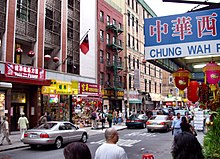A request that this article title be changed to Chinese languages in the United States is under discussion. Please do not move this article until the discussion is closed. |

| Chinese speakers in the United States | |
| Year | Speakers |
|---|---|
| 1960a | 89,609 |
| 1970a | 190,260 |
| 1980[1] | 630,806 |
| 1990[2] | 1,319,462 |
| 2000[3] | 2,022,143 |
| 2010[4] | 2,808,692 |
| ^a Foreign-born population only[5] | |
Chinese languages, including Mandarin and Cantonese, are collectively the third most-spoken language in the United States, and are mostly spoken within Chinese-American populations and by immigrants or the descendants of immigrants, especially in California and New York.[6] Around 2004, over 2 million Americans spoke varieties of Chinese, with Mandarin becoming increasingly common due to immigration from mainland China and to some extent Taiwan.[6] Within this category, approximately one third of respondents described themselves as speaking Cantonese or Mandarin specifically, with the other two thirds answering "Chinese", despite the lack of mutual intelligibility between different varieties of Chinese. This phenomenon makes it more difficult to readily identify the relative prevalence of any single Chinese language in the United States.[7]
According to data reported on the 2000 US census long-form, 259,750 people spoke "Cantonese", with 58.62% percent residing in California and the next most with 16.19% in New York.[8] The actual number of Cantonese speakers was probably higher. In the 1982–83 school year, 29,908 students in California were reported to be using Cantonese as their primary home language. Approximately 16,000 of these students were identified as limited English proficient (LEP).[9]
According to data reported on the 2000 US census long-form, 84,590 people spoke "Taiwanese Hokkien".[10] The county with the most Hokkien speakers was Los Angeles County with 21,990 (0.250% of County population) followed by Orange County with 5,855 (0.222% of County population). The county with the highest percentage of Hokkien speakers was Calhoun County, Texas at 0.845% (160) followed by Fort Bend County, Texas at 0.286% (935) and Los Angeles County, California. According to data collected from 2005–2009 by the American Community Survey, 76,822 people spoke Taiwanese Hokkien.[11]
In New York City, Standard Mandarin Chinese was spoken as a native language among only ten percent of Chinese speakers as 2002, but was being used as a secondary dialect and replacing Cantonese as their lingua franca.[12]
| State | Chinese speakers |
|---|---|
| California | 815,386 |
| New York | 374,627 |
| Texas | 91,500 |
| New Jersey | 84,345 |
| Massachusetts | 71,412 |
| Illinois | 65,251 |
- ^ "Appendix Table 2. Languages Spoken at Home: 1980, 1990, 2000, and 2007" (Table). United States Census Bureau. Archived from the original on July 24, 2017. Retrieved August 6, 2012.
- ^ "Detailed Language Spoken at Home and Ability to Speak English for Persons 5 Years and Over --50 Languages with Greatest Number of Speakers: United States 1990" (Table). United States Census Bureau. 1990. Archived from the original on July 18, 2018. Retrieved July 22, 2012.
- ^ "Language Spoken at Home: 2000". United States Bureau of the Census. Archived from the original on November 29, 2014. Retrieved August 8, 2012.
- ^ "2010 American Community Survey 1-Year Estimates: Language spoken at home by ability to speak English for the population 5 years and over". United States Census Bureau. Archived from the original on December 5, 2014. Retrieved December 14, 2012.
- ^ "Mother Tongue of the Foreign-Born Population: 1910 to 1940, 1960, and 1970" (Table). United States Census Bureau. March 9, 1999. Archived from the original on July 18, 2018. Retrieved August 6, 2012.
- ^ a b Lai, H. Mark (2004). Becoming Chinese American: A History of Communities and Institutions. Walnut Creek, CA: AltaMira Press. ISBN 0-7591-0458-1.
- ^ Cooc, North; Leung, Genevieve. "Who are "Chinese" Language Speakers in the United States?: A Subgroup Analysis with Census Data" (PDF) – via aapidata.com.
- ^ "Cantonese" (PDF). Archived from the original (PDF) on April 2, 2016. Retrieved April 28, 2016 – via usefoundation.org.
- ^ A Handbook for Teaching Cantonese-Speaking Children (PDF). Sacramento: California State Department of Education. 1984. Archived from the original (PDF) on October 5, 2016. Retrieved October 4, 2017.
- ^ "Formosan" (PDF). Archived from the original (PDF) on April 3, 2016. Retrieved April 30, 2016 – via usefoundation.org.
- ^ "Census Data & API Identities". Asian Pacific Institute on Gender-Based Violence. Archived from the original on June 9, 2016. Retrieved October 4, 2017.
- ^ García, Ofelia; Fishman, Joshua A. (2002). The Multilingual Apple: Languages in New York City. Walter de Gruyter. ISBN 3-11-017281-X.
- ^ "Table 5.Detailed List of Languages Spoken at Home for the Population 5 Years and Over by State: 2000" (PDF) (Tables). United States Census Bureau. February 25, 2003. Archived from the original (PDF) on January 17, 2010. Retrieved October 3, 2012.
